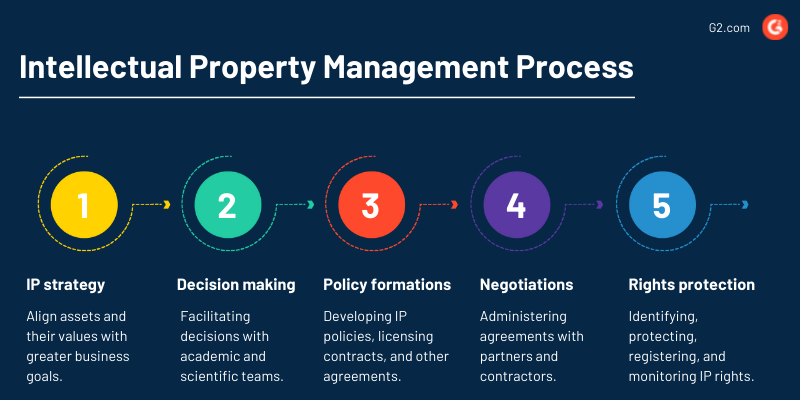

Managing intellectual property is not easy. Or is it?
Intellectual property (IP) is one of the most important assets of any business. It sets businesses apart either by IP, such as trademarked logos, copyrighted slogans, or by confidential research information.
Owning intellectual property symbolizes innovation and creativity within a company. Managing these assets requires time, effort, and money. Protecting your creations is not an easy task.
With technology like intellectual property management software, it's possible to centralize information while staying updated with various IP filings and intellectual property rights infringements. Leveraging these systems provides the benefit of simplifying the intellectual property procurement lifecycle from litigation to payments.
Intellectual property (IP) management is a system that helps manage intangible products such as creations of the mind and human intellect. The main types of intellectual property include patents, copyrights, trademarks, trade secrets, and geographical identifications.
The process of intellectual property management (IPM) comes into play when businesses need to effectively develop a system that tracks and records IP assets in a streamlined manner.
IPM is also essential in building a strategy dedicated to intellectual property and aligning that strategy with the organization’s overall product and growth goals.
Managing IP assets requires buy-in from executives, technology managers, technical writers, product developers, and engineers. Businesses must treat the process as one that affects internal and external stakeholders because IPM is critical to the development, distribution, and sales of goods and services.
Large enterprises often overlook the significance of leveraging intellectual property with greater business objectives. They tend to hold hundreds of patents but do not have a strategy to capitalize on those with existing products and greater business goals.
Management of intellectual property is important for businesses because it:
Creating and maintaining a well-documented IP management process adds significant value to business activities.
Along with serving as a knowledge source for internal and external stakeholders, a functional intellectual property management process identifies, protects, and retains the intangible product and its value.

An effective IP strategy must identify assets and align their value with the company's commercial goals. It’s also imperative to understand competitors’ assets and to gain knowledge about different intellectual property rights and infringements.
A standard intellectual property strategy aims to protect, enforce, and manage assets. There are four basic IP strategies that organizations can build upon to suit their business objectives.
Once the IP strategy is in place, it must be implemented to clarify asset values and achieve desired outcomes.
Generating and retaining profits from intellectual property requires careful deliberation and discussion with both creators of the asset and business leaders. The intellectual management process will remain incomplete without the absolute visibility of the action items noted in the strategy.
Formulate frameworks for setting up dedicated IP management teams, educating employees about intellectual property, and communicating the business’s IP policies and plans of action. Develop structures for licenses, contracts, and related agreements.
Even though the IP process is no longer siloed to the legal department, legal service providers still play an integral role in managing assets. Turn to experts and commercial partners who can administer relevant agreements and assist in conducting necessary negotiations.
Intellectual property is essential to a business as it acts as a way to recognize, support, and promote the company’s products and culture. It is imperative to protect intangible ideas and assets to extract value and invest in innovation and creativity.
Provide internal resources so employees are well versed in the different types of business assets (patents, copyrights, trademarks), associated IP rights, and potential violations by third parties.
Even though IP assets are intangible, the process of IP valuation is necessary to be able to sell, license, or use the assets in the commercial space. Every IP asset has a value attached to it that enforces respective IP rights, internal asset management , and overall financial operations.
Direct valuation. The value of an intangible asset is directly derived from the IP rights that owners have over goods and services. An IP asset is quantifiable if:
Future valuation. IP asset valuation can also be viewed through the lens of future benefits that they may provide to the owner and authorized users. The future value of intellectual property is derived from:
Valuating any kind of asset requires time and effort, along with comprehensive research of the economy, market prices, and factors that affect the valuation process directly.
There are three main ways to value IP assets:
All intangible assets can provide tangible economic benefits to their owners in an ideal world, but this is often not the case. Some assets cannot be listed on company balance sheets, but changes in their stock prices reveal their value.
To value IP assets with expiration dates, such as patents and copyrights, amortization is used to decrease the property’s value over time. By doing this, companies can decrease their income by expensing annual taxes as the life of the IP asset reduces.
Now is the time to get SaaS-y news and entertainment with our 5-minute newsletter, G2 Tea , featuring inspiring leaders, hot takes, and bold predictions. Subscribe below!

Intellectual property affects a business’s financial performance, customer base, inventory management , and external investments. Each type of intellectual property is different from the other and therefore requires different forms of treatment to estimate its real value to make accurate valuation decisions.
While IP assets and their rights can be transferred legally, certain risks are associated with this practice. Four types of insurance policies exist to protect against transferring risks.
Infringement coverage (also called defense coverage) is the most common type of coverage. This policy provides insurance to owners when a patent infringement claim is filed. It protects the distributors against allegations, maintains rights, and covers damaging costs in case of liabilities.
When an insurer provides funds to IP owners to protect infringement rights and then takes money for legal expenses such as counterclaims and losses, it falls under enforcement coverage. This coverage can also be applied to third-party non-payments, breach of contract, and investigation costs.
This coverage ensures that the IP asset being disputed within a transaction is valid and can be justified for a company’s liability suffering and misappropriation of rights.
Its primary business use case is in mergers and acquisitions. It is aimed toward warranties and representations attached to intangible assets such as IP portfolios, corporate sales, and single assets.
In cases where incorrect claims are made against IP assets that have resulted in a loss of revenue for an insured portfolio, this coverage is used to compensate for direct loss.
Additionally, products that can generate revenue in the future, such as royalties, license incomes, and research and development expenses, are covered under this insurance policy.
The assets may be intangible, but the risks are real and serious if not identified and mitigated. Companies that deal with intellectual property must plan for risks and allocate necessary resources to comply with the legal and regulatory measures.
Although intellectual property has long been seen as a legal issue dominated by IP law firms , there is a collective rethinking of the subject due to its strategic importance and impact on businesses.
Companies view IP assets as a business problem. They are more eager nowadays to understand the process behind asset valuation and litigation practices to further innovation and creativity.
Risk management strategies are also witnessing a change as many organizations are turning to cloud-based IP management software to improve financial efficiency, ensure data security, and increase profits.
Regardless of company size or the number of its intellectual properties, businesses must prioritize the need for both internal and external knowledge on the vast subject matter of IP assets. They play a significant role in the overall growth and profitability of a company.
Using the right kind of risk management strategies, planning for risk mitigation, and aligning business goals with the right standards and policies for IP asset management are key to success in the market.
As is evident by now, owning and managing intellectual property are two different aspects of the same greater business necessity. Investing in the process of intellectual property management requires time, effort, and resources to ensure success.
Intellectual property management systems assist businesses in tracking patents, copyrights, trademarks, and other intellectual property.
A common use of this technology can be seen in legal firms; experts use the software to manage all types of IP data. Additionally, new and ongoing filings can be documented along with keeping an eye on legal violations and infringements.
To be included as a software solution within this list, a product must:
* Below are the top 5 leading intellectual property management software solutions from G2’s Spring 2022 Grid® Report. Some reviews may be edited for clarity.
IPfolio is a cloud-based IP management system that creates and manages corporate IP portfolios. It improves portfolio visibility and facilitates collaboration across global teams.
The software has complete integrations with the Intellectual Property Awareness Network (IPAN), including patent annuities and trademark renewals.
“IP Folio is a very modern cloud-based system that is highly adaptable and configured to our business needs. It is unique in its offering with a modern user interface, email integration, advanced reporting and dashboard capabilities, and easy-to-change workflows.”
“There is still the odd bug here and there as a result of our transition to Salesforce Lightning. However, the IPfolio team has been quick to resolve once we raise an issue.”
Alt Legal is an IP an automated docketing solution for United States Patent and Trademark Office (USPTO) and Canadian Intellectual Property Office ( CIPO) deadlines. The technology also has one-click reporting, smart email templates, calendar syncs, Trademark Electronic Application System (TEAS) integrations, and a §2(d) trademark watch for all §2(d) office references.
“My favorite features include the Patent and trademark reporting tool, invention workflows, regular docket deadline reminders, and the extremely intuitive and easy to navigate Alt Legal platform.
Alt Legal has transformed our IP management tool for the better. Can't recommend this highly enough to in-house counsels struggling with high costs of external IP counsel.”
“I'd love to see the ability to customize questionnaires and all aspects of the intake process. More robust copyright management options would also be nice along with a Zapier Integration.”
With built-in IP business logic, PATTSY WAVE increases operational efficiency, reduces risk, and improves accuracy. Its signature single-screen design makes the integrations with DNS and Anaqua Services a powerful combination.
“Easy to see deadlines and action columns at a glance! I also like the updated version where we can sort inventors without removal and re-additions.”
“The general and license modules need serious attention. Trademark and patent enforcement docketing do not work well in the general module. The system also requires a more modern interface addressed by the team.”
AppColl is a cloud-based patent and trademark management system that helps firms and multinational corporations create and file patent applications cost-effectively. Its product, Prosecution Manager, increases productivity while reducing the risks of running a corporate IP group.
“AppColl makes sure that the data is in the user’s control. The billing system is straightforward and produces invoices in formats uploaded into client billing systems. AppColl's customer support also responds to questions on the same day.”
“It doesn't do everything yet. I would like better file integration with Google Drive or some cloud service. File syncing is pretty brutal in AppColl, so consider using another service for big-time file syncing and work.”
A high-performance cloud-based intellectual property docket reminder system, DocketTrak manages patents and trademarks.
It connects to the USPTO, CIPO, Australia (AU), and Europe (EU) offices and provides real-time event updates and deadline reminders. Its Patent Application Information Retrieval (PAIR) Connect feature imports patent records for effective record management.
“The flexibility of building my docket triggers and forms is huge, and being able to send reminder and completion e-mails and letters right from the platform along with auto-docketing of new matters saves me time. Pricing is great.”
“It would be nice to be able to create reports rather than views. The statuses are also a little granular. An additional helpful feature would be including high-level statuses like unfiled, pending, allowed, granted, expired and then the secondary granular statuses.”
Owning intellectual property gives a competitive advantage to businesses while providing them with legal protection. IP assets prove to be of value to an organization since they generate awareness and revenue from customers and other stakeholders.
Enforcing intellectual property rights makes asset management effective and efficient. Developing plans, IP strategies, and systems with the right software are integral to promoting internal and external innovation and maintaining intellectual property freedom.
Regardless of the nature of an asset, managing it is an important business activity. Learn how asset management increases operational efficiency and reduces maintenance costs.
Aayushi Sanghavi is a Campaign Coordinator at G2 for the Content and SEO teams at G2 and is exploring her interests in project management and process optimization. Previously, she has written for the Customer Service and Tech Verticals space. In her free time, she volunteers at animal shelters, dances, or attempts to learn a new language.